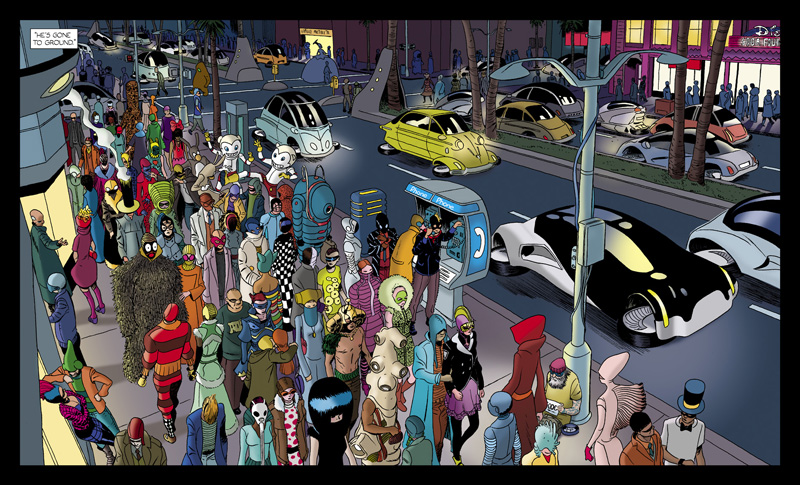In a world of ubiquitous computing—in which technology draws us ever further from an immersive experience and seeks instead to mesh seamlessly with our very existence in “the real world”—I find it easy to be nostalgic for my desktop computing rituals of the past. Like many of my age and privilege, my family was first connected to the internet when I was 9 or 10. Though the purpose of such network access escaped me at the time, “surfing the web” soon became part of the computer ritual I already enjoyed so much: waking up early on the weekends, sealing myself off in the computer room (remember those?) and exploring a technology I hardly understood yet which utterly fascinated me. I installed new games and applications, perused the bowels of Mac OS, played around with system settings, created horrible extension conflicts, corrected extension conflicts and generally had a blast. I remember the experience as hopeful, optimistic—an entire undiscovered world lay awaiting me within my own home. It was a great way to start one’s day.
Perhaps it’s nostalgia for this experience which keeps me so interested in desktop-style computing. Or, a long-held affinity for computer games, most of which are impossible to play any other way. Regardless, it is the intersection of these interests, the desire for an immersive experience, exploration and exposure to new concepts which has defined the personal computer’s place in my life. Many of the online communities I frequent today are vestiges of the technology and game-oriented message boards which comprised my computer rituals of the past. One such community has become very important to me in the past few years: Through The Looking Glass—a website and forum dedicated to the now defunct computer game developer Looking Glass Studios. It has existed and thrived for the past eighteen years.
Looking Glass Studios was an outlier in game development, the kind of outlier common enough in the world of 90s PC gaming to make one excited about the future. Employing many MIT graduates, the Cambridge-based company’s games were often built as simulations first, using complex physical models to allow an unprecedented level of player freedom and immersive gameplay. Game concepts were unpretentious yet involving; simple notions gave way to complex, tactical experiences. The studio is best known for the development of three distinct franchises: the Ultima Series, System Shock and the subject of my personal interest, Thief.
Thief is a weird game—even (or rather especially) by today’s standards. Thief is a first-person shooter where the choice to engage an enemy is usually a poor one. It is essentially a thieving simulator. The player takes the role of Garrett, a sarcastic, world-weary thief living in the vaguely steampunk locale known only as The City. There are some subtle upstairs/downstairs-style inequalities here (witnessed first hand, of course) as well as an overall plot involving chaos and order, with the player as a mediator, but none of that really matters. What makes Thief so great is its atmosphere and gameplay. A typical mission involves infiltrating a mansion, city building or obscure fortress, stealing things, accomplishing the odd plot-driven objective, and escaping. A straightforward battle with a guard will generally end in failure—the player must stick to the shadows and keep his or her noise to a minimum in order to complete their objectives. This all takes place in complex, maze-like environments that put most modern level designers to shame.
The enduring appeal of such an experience—and an apparent inability of the game industry to provide such an experience today—has resulted in one of the most interesting and consistently impressive fan modding communities in existence. Over the past fifteen years, a dedicated Thief fan base has developed and released thousands of missions, many approaching or exceeding the quality of those included in the original game and its sequel, Thief II: The Metal Age. In all honesty, I had never played Thief or its sequels until only a couple years ago, though it’s often been on my radar; Thief and Thief II were among my childhood best friend’s favorite games, but I had a Mac at the time and just never got around to playing them until 2012. They remain the best experience I’ve had playing games since the early 2000s. Quickly completing the included missions, I began to research the world of fan missions for which the game is known. I discovered numerous websites dedicated to archiving, reviewing and releasing missions, websites like “Cheap Thief Missions,” and “Thief: The Circle,” all of which eventually led me to the epicenter of the fan mission community: the forums on Through The Looking Glass.
What struck me was the momentum the community still had. Though the first fan missions were released in 1999, some of the best, and those that seemed to generate the most excitement, have been released in the past few years—some of my favorites were released in 2013 and 2014. Mission contests—wherein an author must develop his or her mission with certain rules in mind—have been and continue to be common throughout this period. As is common in the industry, many high profile fan mission authors have gone on to work with professional game developers. The community is distinctly international with much fan mission development taking place in France, Germany and Finland. Though mission quality varies, I am often surprised at the attention paid by authors to creating a holistic, atmospheric experience; some build entire worlds, rife with metafictional components which reflect their visual and auditory aesthetics.
In addition to original content, many modifications that enhance the game’s graphics and stability have been released, the most major of which surfaced in September of 2012. The so-called “New Dark” patch for Thief 2 was posted anonymously to a French language message board; the update provides a significantly improved experience for Thief 2 and even includes a built-in fan mission loader. The origins of the patch are still unknown, though many argue that only the game’s original developers would have the necessary knowledge to release such an extensive update.
It is not hyperbole to say that my discovery of Thief and its associated fan mission community has enriched my life. The ritual of researching and playing new missions and engaging with their authors and other players has returned an exploratory aspect to my computer usage depressingly absent from the consolidated social networks that dominate the internet today. Rather than mere nostalgia, Thief and its fan missions are a reminder that the internet did and still can provide meaningful, positive, largely commercial-free communities which thrive on a desire for new experiences.
The Thief fan mission message board at Through The Looking Glass can be found here: http://ttlg.com/forums/forumdisplay.php?f=100. If you’re interested in playing Thief or Thief 2, the best place to purchase them legally is from http://www.gog.com/. The “New Dark” patch for Thief 2 can be found here: http://www.ttlg.com/forums/showthread.php?t=140085 and the latest fan patch for Thief Gold is available here: http://www.ttlg.com/forums/showthread.php?t=134733. Once you’ve purchased the game(s) and downloaded the appropriate update, you may begin to browse the huge world of fan missions. Beyond the TTLG forums, the two best resources for fan missions are Cheap Thief Missions (http://thiefmissions.com/) and Thief: The Circle (http://www.thief-thecircle.com/missions/).
:::
Jonathan Scheer is a young man and Virginia native. He enjoys music, reading and computer games.




